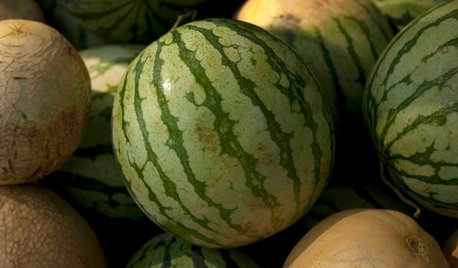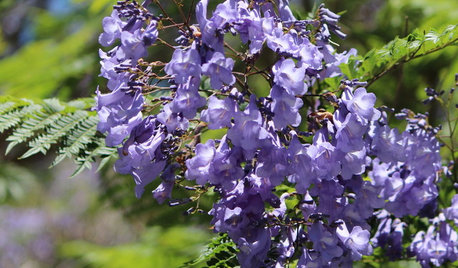Harvesting Melons: How do you know when a melon is ripe?
This is a difficult thing for the home gardener to determine no matter what melon it is. Even specific types will vary depending on what variety it is. The best way to determine maturity of an entire field is to randomly select melons from across the field and use a hand refractometer to measure the sweetness of the melon. Soluble sugars should be 10% or more near the center of the melon. Since most home gardeners probably aren't going to go so far as to aquire that equipment, here are some tips:
All "melons" are Cucurbits (Cucurbitaceae). The cucurbit family includes species such as the gourd, watermelons, cantaloupes, squash and pumpkins.
Melons like cucumbers require ample moisture for the growth and fruit setting. During the fruiting ripening stage, however, too much water will diminish the flavor of the melons.
1. When harvesting, make sure that the melon is cut from the vine instead of pulled. Pulling creates a cracking wound that pathogens can enter and quickly destroy the quality of the fruit, not to mention ruining the appearance of the fruit. Leave the stems on the melon for as long as possible, and treat for stem end rot after picking.
2. Don't harvest your melons until they are fully ripe. Melons will get softer after they are picked from the vine but they will never get sweeter.
3. Most people tap on the fruit and listen for a dull thump. If you grow many of them, this is an art form.
Muskmelons: Varieties with netted skin such as the muskmelon and Galia types are easy to tell when they are ripe because the fruit pulls off easily or "slips" from the vine.
They should be harvested at full "slip" when the ground color under the net starts to turn yellowish. Eating maturity follows in 1 to 3 days and best flavor is obtained if melons are held near 70 degrees F. for this final ripening. If muskmelons are to be held longer, 50 degrees to 55 degrees F. is best.
Varieties with smooth, harder skins such as honeydews or casabas do not slip and must be cut from the vine. The skins of these varieties actually feel hairy when the fruit is not ripe. As the fruit matures, the skins become smooth and slippery and some varieties change color. When the fruit is fully ripe, the skins change again to have a waxy feel. In addition, the blossom end should have a ripe, fruity smell.
Smell the fruit. Both cantaloupes and honeydew have a strong sweet smell, which is especially evident when the melon is at room temperature.
Listen: Honeydew will rattle from loose seeds when ripe. Cantaloupes are unreliable rattlers and this doesn't work on them. Thump it. Knock on it as if it were a door a couple of times or slap it. A deep and thick dense sound is good a hollow sound can mean insufficient moisture. If ripe, it will resonate with a hollow thump.
Watermelons: It is extremely difficult to tell if a watermelon is ripe by just looking; it must be examined. Watermelons will not continue to ripen after harvest. Hold the harvested fruits at 50 degrees to 60 degrees F. Here are indications you can look for:
1. Thump it. If the watermelon sounds hollow (if you hear a dull thump/thud), the melon is usually ripe. This is difficult for less-gifted ears. The unripe melon will have a tighter, metallic ringing or hollow sound. This technique is not perfect however, because the dull sound you hear doesn't indicate if the melon is overripe.
2. Use the criteria of approximate size for variety,
3. Ceasing of growth.
4. Look at the color on the top. The watermelon is ripe when there is little contrast between the stripes. Another indication is when the surface color of the fruit turns dull.
5. Look for the spot where the melon rested on the ground; a yellow-white, yellow or a cream-yellow color spot suggests ripeness and a white or pale green spot indicates immaturity. A green watermelon will have a white bottom; a ripe melon will have a cream- or yellow-colored bottom. Those fruit that show a change of color from green or olive-grey to yellowish brown should be considered ready to harvest. Also look for a breakup of green bands at the blossom end of the fruit. For best quality, walk the patch daily.
6. The rind at the soil spot should toughen and resist denting with a fingernail when the melon is ripe. Scratch the surface of the rind with your thumbnail. If the outer layer slips back with little resistance, showing a green-white color under the rind, the watermelon is ripe. Feel for development of ribbed indentations that can be felt with finger tips. It should be firm but not a rock. If soft or soft spots it's too far gone. Sponginess is bad.
7. Press on it. If the watermelon sounds like it gives a little, it's ripe. (This method can also ruin the quality of the fruit.)
8. Check the tendril. If the tendril is green, you should wait to pick the melon. Harvest when the curled tendril near the stem, the "pigtail" or tendril closest to the melon on the vine begins to shrivel and dry up. If it dries while the leaves and rest of the vine looks good, the melon should be ripe.
9. Harvest when a small crack appears in the stem just above the melon indicating the melon is ripe. If it's half-dead, it could mean that the watermelon is nearly ripe or ripe. If the tendril is fully dead, it could mean that anthracnose or some other fungus killed the melon, or that it's ripe or overripe. The drying of the stem tendril nearest the attachment point and green color tone are also indicators of ripeness. Sign vary with cultivars.
10. Count the number of days from anthesis (flowering) or the number of days from planting. This works pretty well if you know the variety of watermelon and how many days it's supposed to take for that variety to ripen under normal temperature and fertilizer regimes.
11. The slipping of the stem from the melon with slight finger pressure is an excellent indicator of melon ripeness in the field.
Hold a melon up to your ear, if you can feel it squeeze and hear a slight mush instead of a crack it is ripe.
7 Check the size. It's not necessarily true that when a watermelon is big enough, it's ready; but under good conditions, it should be normal size. If it's not, you're probably too anxious.
8 Crack a few. You've got a whole field of watermelons, and you can practice a little, right?
9 Is the vine dead or dying? Well, the watermelon is not going to get any riper, so you might as well pick it
10. Rely on your nose, and look for a melon with the strongest fragrance, for this will most likely be the best tasting. Breath deeply and follow your nose to the sweet ripe melon. Sniff the aromatic one out. Next, look for a melon that is heavy for its size, because if you have two melons of equal size, the heavier one is almost assuredly the riper and better tasting melon. Smell is something you learn with experience.
11. Still confused? Guess. All indicators will not always work. Take your best shot and go with it.
Specific Melons:
Ambrosia Melon - This netted muskmelon is very similar to the American cantaloupe. The flesh is a deep orange and has a more intense flavor. The scent of the melon, when ripe, is very strong and appealing.
American Cantaloupe - The melons commonly called cantaloupe in the States are actually not technically cantaloupes, although they are a very similar member of the muskmelon family. True cantaloupes are natives of Italy and are only found in Europe. The skin of the American cantaloupe is beige with a grey toned netting flesh is very sweet and pale orange. Ripe "cantaloupes" should be heavy for their size, be very fragrant, and be slightly soft at the blossom end. The skin should be uniform with no soft spots or bruises and the netting should be fairly well defined. "Cantaloupes" really absorb flavors from other foods and should not be stored in close contact with strong smelling foods for any length of time. When most recipes call for cantaloupe this is the melon they are referring to and they are really interchangeable with the "true" cantaloupe in recipes.
Butterscotch Melons - These buttery rich melons are becoming increasing popular at local farmers markets and specialty grocery stores around the country. These small melons have a pale green skin and a two-toned green and orange flesh. The green flesh nearest the rind is edible, and very sweet. Many people think the flesh tastes like butterscotch candy, which is where the name comes from. Ripe melons are paler in color with a sweet sugary aroma.
Cantaloupe - Although similar to what most Americans call cantaloupes, true cantaloupes are only found in Europe and are not exported. The skin is beige with a grey toned netting flesh is very sweet and pale orange. Ripe cantaloupes should be heavy for their size, be very fragrant, and be slightly soft at the blossom end. The skin should be uniform with no soft spots or bruises and the netting should be fairly well defined. Cantaloupes are unripe when the skin beneath the textured 'web' is green and ripe when orange or golden.
Casaba Melon - The casaba melon is a large melon with a thick-ridged yellow skin. The flesh is wonderfully mild and juicy in flavor, and has a very creamy vanilla-orange color. They are usually available in the mid to late fall. The easiest way to choose a ripe casaba is to look for a slightly soft blossom end. Leave the casaba melon on the vine until the blossom end softens and rind turns yellow. Harvest when the skin is slightly golden and the flesh is white.
Charentais Melons - Charentais melons, also called French or French Breakfast Melons are considered by many to be the most divine and flavorful melons in the world. Increasingly popular and quite expensive, they are showing up in markets all over the States. The skin is a grayish yellow-green color and the flesh is very sweet and pale orange. The melons are typically the size of large grapefruits and weight about two pounds. When ripe, Charentais have a wonderfully complex and full bodied aroma with flowery overtones. The skin also loses the grey cast to the skin for a warmer yellow color.
Cranshaw Melon - The cranshaw, or crenshaw melon as it is sometimes spelled, is a very popular and flavorful melon well known for its wonderful aroma and flavor. Available from mid-summer to mid-fall, cranshaws are large oval shaped melons with a yellow-green ridged skin. The flesh is a vibrant orange-pink that has a seductive flavor and scent. Ripe cranshaws are easy to pick out as they are perhaps the most fragrant of melons when they are ripe. Harvest when the blossom end begins to soften and the skin is golden yellow and green. It is ripe when the dark-green skin develops yellow streaks.The flesh should be a golden pink.
Emerald Jewel - These "gift melons" imported from Japan are the latest trend in flavorful attractive melons. They are typically 3-4 pounds in size and have a netted brown and green skin. The flesh is a bright white and very sweet and juicy.
Emerald Pearl - Another "gift melon" imported from Japan, these melons are my personal favorite. They are typically 3-4 pounds in size and have a netted green skin. The flesh is very sweet and green with a delightful crispness that almost borders on crunchy.
Galia Melons - These delightful honeydew melons are oftentimes labeled as Mediterranean, Passport, Israeli, or Middle Eastern melons are actually a group of melons that are very similar. They all have a golden-green netted exterior and pale green flesh. They have a wonderful aroma and sweet and juicy flavor. Generally Galia melons are riper when they have a lighter, yellow skin and a very strong sweet aroma.
Honeydew Melon - One of the most popular varieties of melon, the honeydew melon is available all year round in most markets, although they are at their peak ripeness in the late summer. The melons are large, round, and should be heavy for their size. Honeydews have an exceptionally smooth pale yellow-green skin and succulent pale green flesh. A beige honeydew with distinct green veins reveals immaturity. The best way to tell when honeydew melons are perfectly ripe is to feel the melons. Ripe melons have some very fine veining that you can only detect by touch. The melon should not be soft or scarred in any areas and should be somewhat fragrant. Harvest when the blossom end softens and the stem end is slightly springy and the skin begins to take on a creamy yellow/cream appearance. Pale yellow with bright lemon-colored areas suggests it matured on the vine.
Juan Canary Melons: Juan Canary or canary melons are widely available across the United States during the summer months in major grocery stores. The bright yellow football shaped melons are very distinctive and the cream colored flesh is widely used in salads and desserts. Ripe melons should be very firm, heavy for their size, and slightly fragrant.
Muskmelons: Harvest when firm, well netted, well formed and at 'full slip'. Full slip is when the melon separates from the stem with a slight pressure from the finger. Another indicator of ripening is the skin taking on a slightly yellow appearance under the netting.
Orange-Flesh Honeydew Melon - Growing increasingly popular, the orange-fleshed honeydew (also marketed as the Temptation Melon) is like a cantaloupe with the size and shape of a honeydew. The melons are large, round, and should be heavy for their size. They have an exceptionally smooth white skin and succulent orange flesh that is very similar to cantaloupe, with a bit more delicate honeydew-like flavor. The best way to tell when orange-flesh honeydew melons are perfectly ripe is to look at the skin. Ripe orange-flesh melons turn a pale orange shade when ripe.
Persian Melon - This netted skinned muskmelon has a beautiful green skin and pinky orange flesh. They are very sweet and are slightly larger than the American Cantaloupe. Ripe Persian melons are noticeably heavier than their unripe counterparts and store very well in the refrigerator for up to a week until you are ready to use them. Harvest when the skin begins to turn a mauve color under the net, the blossom ends begins to soften and the flesh has a tinge of orange.
Santa Claus Melon - Also called Christmas melon or December melon, the Santa Claus melon is a very popular melon during the winter when it comes into season. The convenient timing for Christmas, the bright green and yellow skin, and the long-lasting qualities of the melon are all attributed as being the reasons for its unique name. Whatever the reason for the name, the Santa Claus melon is very flavorful and is great for salads and other dishes. Many varieties are quite large, and even though they look like small watermelons on the outside, on the inside they are almost exactly like honeydew melons. The ripest Santa Claus melons have soft blossom ends and a distinct yellow tinge to the skin.
Sharlyn Melon - Sharlyn (also spelled Sharlin or Sharilyn) melons are becoming more and more common in grocery stores because of their wonderful flavor and pretty orange-white flesh. The flavor is delicate and tastes like a combination of honeydew and cantaloupe. Sharlyn melons ripen very quickly and do not store well at all. Ripe melons have an orange tone to their flesh underneath the tan colored netting, while unripe melons are greener in tone.
Sprite Melons - These North Carolina specialties are finally being distributed all across the country. These diminutive melons are about the size of softballs and frequently weight less than a pound. They have a very firm and crisp apple-like flesh and the flavor is something like a mixture between pear, apple, and honeydew and is very sweet. Ripe melons have a mottled yellow skin, while unripe melons are a pale cream color.
Tokyo King - These "gift melons" imported from Japan are the latest trend in flavorful attractive melons. They are typically 3-4 pounds in size and have a netted green skin. The flesh is a bright white and very sweet and juicy. They are the classic slightly oval sweet melons that are very popular in Japan and the West Coast.













Related Discussions
When is 'Halona' melon ripe?
Q
How to tell when melon is ripe
Q
How do I tell when melons are ripe?
Q
How to tell when Green Fleshed Pineapple melons are ripe?
Q